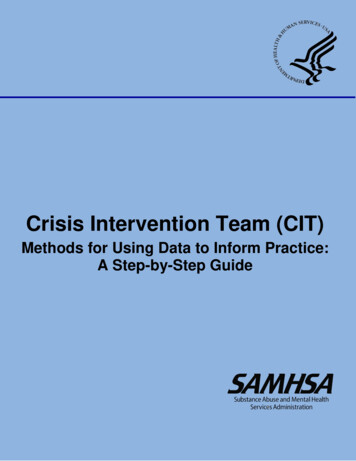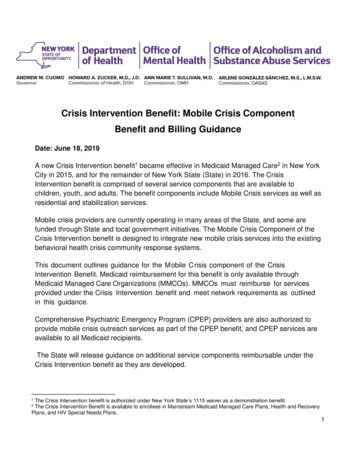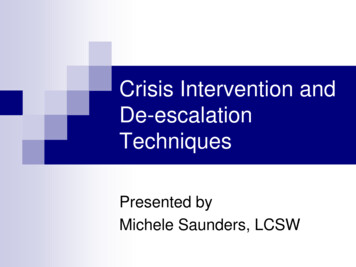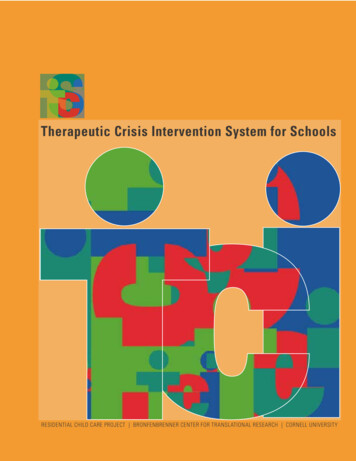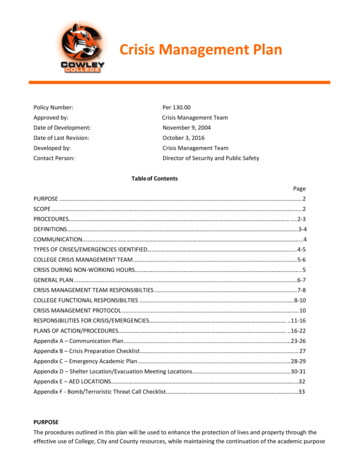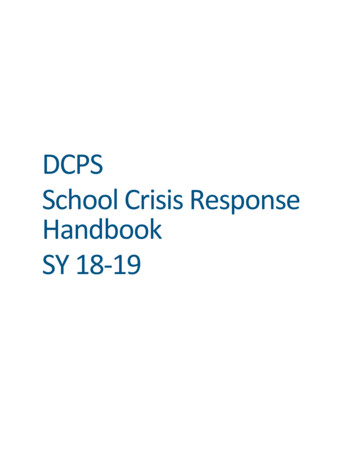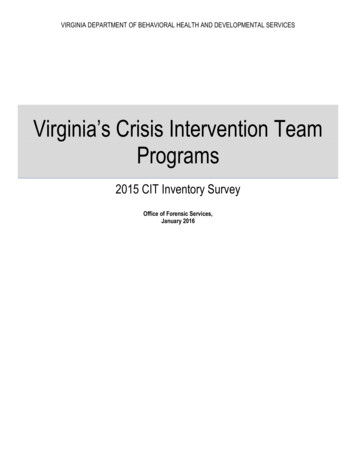
Transcription
VIRGINIA DEPARTMENT OF BEHAVIORAL HEALTH AND DEVELOPMENTAL SERVICESVirginia’s Crisis Intervention TeamPrograms2015 CIT Inventory SurveyOffice of Forensic Services,January 2016
Executive SummaryVirginia’s Crisis Intervention Teams: 2015 CIT Inventory SurveyCrisis Intervention Team (CIT) programs are an emerging, best practice, first responder model of police intervention to enhance publicsafety by aiding those in emotional crisis. At its foundation, CIT relies on cooperative partnerships between law enforcement, other firstresponders, behavioral health providers, persons with lived experience, families, advocates, and the community as a whole. CITprograms are designed to improve the way law enforcement responds to people experiencing mental health crises by providing lawenforcement officers and other first responders with the skills and abilities to recognize signs/symptoms of behavioral health issues andto equip officers with advanced communication and de-escalation skills to successfully assist individuals in crisis. CIT programs alsoteach officers and other first responders how to access behavioral health services for those in crisis and for operational programsprovide officers and other first responders a therapeutic, safe, location where officers can bring individuals in crisis for prompt, thoroughassessment and referral for behavioral health services. Each local program creates a coalition of stakeholders including lawenforcement, emergency dispatchers, mental health providers, hospitals, consumers of mental health services, and others to overseeand guide the program. CIT programs provide advanced training and coordination between local criminal justice and behavioral healthsystems to improve access to services for persons with behavioral health concerns who come into contact with law enforcementwhenever appropriate.The CIT Inventory Survey is an annual survey administered by the Department of Behavioral Health and Developmental Services(DBHDS) and the Department of Criminal Justice Services (DCJS) to assess the status of CIT Programs across the Commonwealth.The following report reflects findings from the 2015 Annual CIT Inventory.In Summary (as of August 1, 2015)1: There are 37 CIT Programs at various levels of operation2 There are 32 CIT Assessment Sites operated by 28 CIT programs CIT programs are active in 117 of Virginia’s 133 localities3 Nearly 95% of Virginia’s total population live in an area where a CIT Program initiative is underway4 620 criminal justice agencies have participated in a CIT program5 9,842 individuals have completed a 40 hour Core CIT training (cumulatively) 6.Total includes:o Police/Sheriffs- 6,877o Corrections –1,349o Other first responders (e.g., Fire/EMS) – 589o Mental Health Practitioners/Consumers –617o Dispatch/Emergency Communications- 4107 1,625 Dispatchers have either participated in 40 hour training or completed a specialized CIT dispatcher course.As an emerging best practice model and to achieve all the positive outcomes associated with CIT, Virginia CIT programs are stronglyencouraged to maintain fidelity to the CIT model as outlined in the “Essential Elements for the Commonwealth of Virginia’s CITPrograms”. The Essential Elements outline the best practice requirements for the development and implementation of CIT programs inVirginia8. The Essential Elements were developed by expert leaders in CIT and provide guidance to programs wishing to implementCIT programs in their community.The Annual CIT Inventory is a self report survey.programs are affiliated with local Community Services Boards (CSBs). Virginia has 40 CSBs, one of which classified as a Behavioral Health Authority(Richmond Behavioral Health Authority). These agencies serve as the point of entry into the publicly-funded system of services for mental health, intellectualdisability, and substance abuse. CSBs provide pre-admission screening services 24-hours per day, 7 days per week.3 ‘Active’ CIT Programs are defined by the presence of CIT trained law enforcement and/or first responders. Programs classified as ‘Developing’ or ‘Operational’ areconsidered ‘Active’. Thirty-three (33) CIT programs are Active. The remaining 4 CIT initiatives are ‘In Planning’ and not considered fully active although they mayhave some officers CIT trained.4 Based on 2014 Virginia population estimate - 8,326,2895 There may be some duplication in this number, as some agencies may have reported the same agencies under both Fire and EMS categories, as well as Sheriff’sDept. and Corrections categories6 The State Compensation Board’s ‘2015 Mental Health in Jails’ Annual Report notes that 8,774 individuals were CIT trained which is considerably lower than thetotal reported here. This report includes Virginia Beach CIT (488), Roanoke CIT (393) and Danville-Pittsylvania CIT (187), whose information was not available at thetime of the State Compensation Board’s report.7 Attending a 40 hour class.8 A copy of the Essential Elements document can be found at http://www.vacitcoalition.org/essential elements of virginia cit12CIT2
Virginia’s Crisis Intervention Teams: 2015 CIT Inventory SurveyVirginia’s Crisis Intervention Team Programs BackgroundCrisis Intervention Team (CIT) programs are collaborative multi-disciplinary programs designed to improve the way peopleexperiencing mental health crises are served in Virginia communities. CIT programs are built on strong local partnershipsbetween law enforcement and other first responders, mental health providers, hospitals, the courts, and individuals andfamilies affected by mental illness. Each local program creates a coalition of stakeholders to oversee and guide theprogram. CIT programs provide advanced training and coordination between local criminal justice and behavioral healthsystems to improve access to services for persons with behavioral health concerns who come into contact with lawenforcement whenever appropriate.CIT in Virginia has its roots in Memphis, Tennessee. Communities in Virginia sought out knowledge of best practices fromthe founders in Memphis and brought CIT to our communities in the early 2000’s. Over the past 15 years, CIT in Virginiahas grown from a handful of programs in diverse regions to a network of 37 programs that collaborate to support bestpractices and continued growth of CIT throughout the Commonwealth. 95% of Virginians live in an area covered by a CITprogram. An informal poll of other states suggests the Commonwealth of Virginia likely has the largest number of CITprograms.In 2009, responding to increasing interest in CIT program development, sections 9.1-102, 9.1-187, 9.1-188, 9.1-189 and190 of the Code of Virginia were amended. The legislation provided a more effective, consistent process for CITdevelopment and oversight, directing the Department of Criminal Justice Services (DCJS) in conjunction with theDepartment of Behavioral Health and Developmental Services (DBHDS) to “ support the establishment of crisisintervention team programs in areas throughout the Commonwealth ”The goals for CIT programs are included in the Code of Virginia, §9.1-187, and are generally oriented toward reducinginjuries to both law enforcement and citizens, reducing arrest of persons in behavioral health crisis, improving access andlinkage to appropriate community treatment and supports, and promoting dignity and respect for individuals with behavioralhealth disorders. In 2011, DBHDS and DCJS, along with the leadership from the Virginia CIT Coalition 9, developed aguidance document (Essential Elements for the Commonwealth of Virginia’s CIT Programs) to establish consistent, bestpractice standards for the development and implementation of CIT programs in Virginia.At its core, CIT provides 1) law enforcement and other first responders with skills and abilities (through comprehensiveadvanced training) to recognize and respond to individuals experiencing behavioral health crises; 2) a forum to promoteeffective systems change and problem solving regarding interaction between the criminal justice and mental health caresystems; and, 3) improved community-based solutions to enhance access to services for individuals with mental illness.Successful CIT programs improve officer and consumer safety, reduce inappropriate incarceration and redirect individualswith mental illness from the criminal justice system to the health care system when to do so is consistent with the needs ofpublic safety.The VACIT Coalition is led by a team of key CIT stakeholders from established CIT programs, along with DBHDS and DCJS staff. VACIT assists with policydevelopment, program guidance, technical assistance and training. VACIT membership is open to any stakeholder interested in developing or involved in a CITProgram in Virginia.93
Virginia’s Crisis Intervention Teams: 2015 CIT Inventory SurveyThe CIT Program Inventory SurveyIn 2012 a Statewide Inventory was developed to collect standardized program information across all of Virginia’s CITinitiatives. The survey is administered once a year and collects information including local stakeholder involvement, trainingsheld, numbers trained, agencies involved, data collected, funding, and other details regarding program implementation.Information collected from the inventory is used by DCJS and DBHDS to assist in policy development, resource allocation,and expansion of CIT across the Commonwealth.I. 2015 CIT Program StatusAs of August 2015, Virginia has 37 CIT Programs at various levels of operation (see Table A). These 37 programs areactive in 117 of Virginia’s 133 localities10 - 95% of Virginia’s total population live in an area where a CIT Program initiative isunderway. CIT programs are classified as Operational, Developing or Planning. Of the 37 CIT programs, 26 areOperational, 7 are developing, and 4 are in Planning. Three CSB catchment areas do not have a CIT initiative underway.Table A: CIT Programs in VirginiaA complete listing of CIT programs, the localities they serve, their classification type, and whether or not they have a CITAssessment Site can be found below in Table B. An overview of how classification types are defined can be found in TableC.133 independent localities are served by 39 CSBs and one Behavioral Health Authority. CIT programs are affiliated with local CSB partners and serve local CSBcatchment areas.104
Virginia’s Crisis Intervention Teams: 2015 CIT Inventory SurveyTable B: CIT Programs 2015CSBALEXANDRIA CSBARLINGTON CSBCIT ProgramLocalities ServedClassificationCITAssessmentSiteAlexandria CITArlington CountyCITRoanoke ValleyCITChesapeake CITChesterfieldCounty CITCity of AlexandriaArlington CountyOperationalOperationalYesYes (2 locations)Roanoke City, Roanoke County, Botetourt County, CraigCounty, and Salem CityCity of ChesapeakeChesterfield CountyOperationalYesOperationalOperationalCOLONIAL CSBColonial Area CITOperationalDANVILLE-PITTSYLVANIACSBDISTRICT 19 CSBDanville/Pittsylvania CITSouth Central CITCities of Williamsburg and Poquoson, James City County, YorkCountyDanville City and Pittsylvania CountyYesYes (co-operatedwith RichmondCIT)YesOperationalYesOperationalYes (2 locations)HAMPTON-NN CSBHampton/NewportNews CITHanover CITRockinghamHarrisonburg CITHenrico CITLynchburg CITColonial Heights, Dinwiddie, Emporia, Greensville, Hopewell,Petersburg, Prince George, Surry, SussexCities of Hampton and Newport NewsOperationalYesHanover CountyHarrisonburg City and Rockingham CountyOperationalOperationalYesYesHenrico County, Charles City County, New Kent CountyLynchburg City, Campbell, Bedford, Appomattox, AmherstOperationalOperationalYesYesTown of Leesburg and Loudoun CountyOperationalYesCounties of Mathews, Middlesex, Gloucester, Lancaster,Northumberland, Westmoreland, King & Queen, King William,Richmond, and EssexFloyd, Giles, Montgomery, and Pulaski Counties and the Cityof Radford.City of NorfolkMartinsville City, Franklin County, Henry County, PatrickCountyPortsmouth CityOperationalYes (2 locations)OperationalYes (2 locations)OperationalOperationalYesYes (2 locations)OperationalYes (co-operatedwith ChesapeakeCIT)Prince WilliamCITRappahannockArea CITThomas JeffersonArea CITRichmond CITPrince William County, Manassas City. City of Manassas ParkOperationalYesCity of Fredericksburg and Stafford, Spotsylvania, KingGeorge, and Caroline CountiesCity of Charlottesville and Counties of Albemarle, Nelson,Fluvanna, Louisa, GreeneCity of ginia BeachCITBlue Ridge CITCity of Virginia BeachOperationalYes (co-operatedwith ChesterfieldCIT)YesOperationalYesWesternTidewater CITFairfax CITAugusta County, Highland County, Cities of Staunton andWaynesboroIsle of Wight, Franklin, and Southampton Counties and SuffolkCityFairfax County, Fairfax City, Falls Church CityOperationalYesMt. Rogers CITWythe, Smyth, Bland, Grayson, and Carroll Counties, and theDevelopingBLUE RIDGE CSBCHESAPEAKE CSBCHESTERFIELD CSBHANOVER COUNTY CSBHARRISONBURGROCKINGHAM CSBHENRICO CSBHORIZON BEHAVIORALHEALTH CSBLOUDOUN COUNTY CSBMIDDLE PENINSULANORTHERN NECK CSBNEW RIVER VALLEY CSBNORFOLK CSBPIEDMONT CSBPORTSMOUTH DEPT OFBEHAVIORAL HEALTHPRINCE WILLIAM COUNTYCSBRAPPAHANNOCK AREACSBREGION TEN CSBRICHMOND BHVRL HLTHAUTHORITYVA BEACH CSBVALLEY CSBWESTERN TIDEWATERCSBFAIRFAX FALLS CHURCHCSBMOUNT ROGERS CSBLoudoun CountyCITMPNN CITNew River ValleyCITNorfolk CITPiedmont AreaCIT InitiativePortsmouth CITDevelopingYes5
Virginia’s Crisis Intervention Teams: 2015 CIT Inventory SurveyNORTHWESTERN CSBNorthwestern CITRAPPAHANNOCK RAPIDANCSBROCKBRIDGE AREA CSBRappahannockRapidan CITRockbridge CITSOUTHSIDE CSBCROSSROADS CSBSouthside CITCrossroads CITALLEGHANY HIGHLANDSCSBEASTERN SHORE CSBAlleghanyHighlands CITEastern ShoreCITGOOCHLAND POWHATANCSBPD1 CSBCUMBERLAND MTN CSBDICKENSON COUNTY CSBHIGHLANDS CSBCity of GalaxWinchester City, Frederick County, Clarke County, WarrenCounty, Shenandoah County and Page CountyFauquier, Rappahannock, and Madison Counties, and City ofCulpeperBath County, Rockbridge County ,City of Buena Vista, and Cityof LexingtonCounties of Brunswick, Halifax, and MecklenburgCounties of Amelia, Buckingham, Charlotte, Cumberland,Lunenburg, Nottoway, and Prince lopingYesIn PlanningCounty of Alleghany and City of CovingtonIn PlanningCounties of Accomack and NorthamptonIn PlanningCounties of Goochland and PowhatanLee, Scott, Wise and the City of NortonTazewell, Russell, and Buchanan CountiesCounty of DickensonCounty of Washington and City of BristolIn PlanningNoneNoneNoneTable C: Classification Type DefinedClassificationTask ForceCIT CoordinatorTrainingsOperationalTask Force meetsregularly, providesprogram oversight andeducational outreach.CIT coordinator inplace24/7 CIT responsecapability (based onnumber or percentageof active CIT officers)DevelopingA well-establishedstakeholder Task Forcein placeCIT coordinator inplace or otherdedicated leadershipSignificant number ofCIT-trained officers andCIT facultyIn PlanningWorking to establish astakeholder Task Force.Studying the CITmodelProviding initial officerand mental healthprovider trainingAssessment Site orProtocolTherapeutic assessment siteexists and is consistentlyutilized and/or protocols are inplace to enhance linkage toservices and reduce officerinvolved call timeDataCollects data to assessprogram effectivenessWorking toward theimplementation of a therapeuticassessment location or theestablishment of protocols toenhance service linkage in lieuof incarcerationDeveloping partnerships toaddress options forimplementing assessment sitesor establishing protocols toenhance linkage to servicesand reduce officer involved timeon mental health calls6
Virginia’s Crisis Intervention Teams: 2015 CIT Inventory SurveyII. Participating Criminal Justice AgenciesIn 2015, 620 criminal justice and other first responder agencies participated in a CIT program 11. This is over three times thenumber of participating agencies reported in 2012 (191 in 2012). Participating agencies in 2015 include police departments(141), university police (22), sheriff’s offices (111), other first responder agencies/Fire and EMS (146), 911dispatch/emergency communications (105), and others such as correction agencies, jails, and courts (95). Table D providesan overview of the type and number of agencies participating in a CIT initiative.Table D: 2015 Participating Agencies12III. CIT Training: 40 Hour CoreCIT programs enhance community collaboration, develop effective infrastructure, and provide outstanding law enforcementtraining. A basic requirement of the CIT training is 40 consecutive hours of training delivered over five days. The 40-hourtraining includes a didactic component, an experiential component and a practical component. Although there is localflexibility for special populations and topics, there are some core components/modules which must be taught in order tomaintain fidelity to the CIT model. Additionally, CIT training was developed taking into account adult learning styles and isincremental - building skills throughout the week in a progressive manner. Thus a specific order of training is required byVACIT programs.Agency participation implies that individuals from that agency have received CIT training.The first inventory in 2012 did not ask respondents to distinguish between police departments and sheriff’s offices therefore the 147 total combines PD’s and SO’s.The second inventory (2013) did not distinguish college/university police from police departments, or 911 dispatch from ‘Other Criminal justice Agencies’’. Pleasenote those agencies are represented under police departments and other CJ agencies.11127
Virginia’s Crisis Intervention Teams: 2015 CIT Inventory SurveyBelow is the order of these core components:Monday Introduction to CIT Basic Mental Health Diagnoses (Clinical States) Hearing Voices Practical ExerciseTuesday Site VisitsWednesday Basic Crisis Intervention Skills & The Four Coaching Plays (must take place immediately before Basic Role PlayExercises) Basic Role Play ExercisesThursday Intermediate Role Play ExercisesFriday Advanced Role Play ExercisesDidactic CIT training must include modules on: Basic Mental Heath Diagnoses or Clinical StatesBasics of Substance Abuse and the Medical ModelBasics of Intellectual and Developmental DisabilitiesPsychiatric MedicationsVerbal De-escalation and/or Crisis Intervention SkillsSuicidalityLegal Issues (e.g., liability, CIT Code provisions, etc.) and Civil CommitmentOverview of Special PopulationsCultural DiversityOther topics such as Adolescent Issues, Intellectual Disability/ Developmental Disability Issues, Veterans Issues, and GeriatricIssues, or other region specific or topical areas should be added by programs as needed, and as long as the basic core curriculumis provided. Required module length may vary from program to program with the exception that Legal Issues and Civil Commitmentmust be four hours and Cultural Diversity must be two hours, based on legislative or departmental requirements and in order toprovide the full 2 years of credit for DCJS officer training requirement.As of August 1 2015, 9,842 individuals completed a 40-hour CIT Training. Of that total, 6,877 were Police/Sheriffs, 1,349were Correctional Officers, 589 were Other First Responders (Fire/EMS), and 617 were Mental Healthpractitioners/consumers, and 410 were Dispatch/Emergency Communications. Table E provides an overview of the totalnumber CIT trained.8
Table E: Total Trained13Virginia’s Crisis Intervention Teams: 2015 CIT Inventory SurveyCIT Training for 911/Emergency DispatchAs CIT programs grew throughout the Commonwealth there was a recognition of the value of providing CIT like training for911/Emergency Dispatchers and a specialized curriculum just for dispatchers was developed focusing on the skills a911/Emergency Dispatcher might need for a mental health/behavioral health call. The CIT Dispatcher training wasdeveloped as an advanced training to supplement the training dispatchers already receive. Starting in 2013, a separatecategory for Specialized CIT Dispatcher training was collected. In 2013, 101 individuals had completed a specialized CITtraining for Dispatchers. By 2014, this number had increased to 602. In 2015, 1,215 dispatchers had attended a specializedCIT training for Dispatchers. Table F on page 10 provides an overview.Although it is common that Dispatchers and 911 Emergency Communications representatives go through the 40 hour coretraining, the specialized CIT Dispatcher course provides an opportunity for these individuals to really hone their skills. TheCIT for Dispatchers course is an abbreviated course that is typically 8 hours in length and covers the following topics: Awareness of Mental Health IssuesIntroduction to Clinical StatesSuicide and PTSDHearing VoicesCommunity ResourcesVerbal De-EscalationCrisis ScenariosCorrectional Officers were included with Police/Sheriffs in 2012, and there was no separate category for Dispatcher training. In 2013 a separate category forSpecialized Dispatcher Training (see Table F) was included and in 2014, dispatchers participating in 40 hour class were also identified.139
Virginia’s Crisis Intervention Teams: 2015 CIT Inventory SurveyTable F: Total Emergency/911 Dispatchers CIT Trained: Specialized Class or 40 Hour CITCIT Training: Train the TrainerIn addition to the 40 Hour Core training, CIT programs become self sustaining as they identify key local officers and mentalhealth personnel who have completed the 40 hour training to participate in an advanced “Train the Trainer” course. TheseCIT team members become local Core Faculty and work with the CIT Coordinator to provide the 40 hour training in theirlocality. Recognizing the importance of maintaining fidelity to the CIT model, the Virginia CIT Coalition developed a CITTrain the Trainer curriculum to be used across the Commonwealth. The CIT Train the Trainer course ensures effective andconsistent training across CIT programs. As of August 1st 2015, 113 train-the-trainer classes were held with 1,038individuals in attendance.IV. CIT Task-ForceCentral to the success of CIT is the utilization of local oversight committees or advisory boards, also referred to as a CITTask Force. The CIT Task Force helps to guide the initial planning and implementation of a CIT program. Once a program isestablished, the Task Force provides oversight of the program’s continued operation and sustainability, critical incidentreview, funding and community outreach and education. 33 CIT programs have an established CIT Task Force. Of theseprograms, 14 indicate their task force meets monthly, 4 bi-monthly, 13 quarterly and 2 bi-annually.Task Force membership may include law enforcement, behavioral health, peer/consumers, family members,hospital/emergency departments, magistrates, commonwealth attorneys, defense attorneys, judges, and corrections. TableG on the following page provides an overview of the CIT Task Force membership across programs indicating they had anestablished task force.10
Virginia’s Crisis Intervention Teams: 2015 CIT Inventory SurveyTable G: Task Force MembershipV. CIT Assessment SitesThe ideal CIT program has a physical location that is not a jail or other criminal justice setting, where an officer can take aperson in crisis for assessment and linkage to services. Assessment sites are intended to serve as therapeutic, non-criminaljustice affiliated alternatives to incarceration. Ideally, these sites are intended to be available and accessible for a lawenforcement custodial hand off, clinical assessment for possible civil commitment, referrals and linkage to services for acuteand sub-acute mental health treatment needs 24 hours per day.The Virginia General Assembly has provided 15.9 million to support 32 CIT Assessment Sites as an alternative toincarceration for individuals with serious mental illness. In FY 2015, 3,850 individuals were assessed at CIT AssessmentSites with 2,313 resulting in TDOs.DBHDS will publish a separate report regarding the operations of the CIT Assessment Sites in the Commonwealth.VI. CIT FundingFunding for CIT programs developed from an initial 150,000 Federal Substance Abuse and Mental Health ServicesAdministration (SAMHSA) grant to the New River Valley in 2001, to a complicated patchwork of Federal and state grants,ongoing state General Funds for jail diversion and local program contributions. In 2015, 28 CIT programs received stateGeneral Funds to support their CIT Assessment Sites, 6 programs received a onetime state CIT Development Grant, and 5programs reported that they receive ongoing local funds to support their local CIT initiative. Lack of ongoing, sufficientfunding to support CIT program operations is consistently reported as the number one threat to CIT in Virginia. While theCommonwealth has invested significant resources into therapeutic assessment sites, similar investments to support CITtraining, CIT coordinators, and CIT stakeholder engagement have been lacking.11
Virginia’s Crisis Intervention Teams: 2015 CIT Inventory SurveyOAG Asset Forfeiture GrantsIn addition to funding provided by state and local sources, as the result of a plea agreement by Abbott Laboratories, theOffice of the Attorney General of Virginia made Asset Forfeiture Funds available to state or local law enforcement agenciesto be spent by those agencies for a law enforcement purpose. Nineteen (19) local law enforcement agencies affiliated with aCIT program applied for, and received OAG Asset Forfeiture Awards of various amounts to support their local CIT programactivities. DCJS in partnership with DBHDS and the Virginia CIT Coalition also applied for and received an award of 800,000 to implement a statewide, multi-phased CIT Train the Trainer program. Funding awarded to us was intended toprevent and deter crime and to improve the functioning of the criminal justice system by developing or enhancing CrisisIntervention Team (CIT) programs that met the requirements of the "Essential Elements for the Commonwealth of Virginia'sCrisis Intervention Team Programs (CIT)”.The award to implement a statewide, multi-phased CIT Train the Trainer program utilized existing VACIT trained instructorsas consultants to teach the train the trainers program in teams of four throughout the Commonwealth, and provide technicaland teaching assistance to newly trained instructors as the teach the 40 Hour Core CIT Training Program. Funds werealso used to provide scholarships to operational CIT programs to reserve training slots in their 40 hour class for individualsseeking CIT training from outside jurisdictions, and funds to support mentoring activities to new and emerging CITprograms. Although the original award was to occur over a two year period (January 2014 - January 2016), an extensionwas requested for funds not expended to provide one time grants to support CIT development activities. Grants will beawarded by the end of January 2016.The OAG Statewide CIT Expansion Grant has had a considerable impact on CIT programs over the course of the last twoyears. 20 CIT programs received training assistance. 24 40-hour core CIT trainings were supported averaging 25 studentsper training. In addition, 13 Train the Trainer trainings took place, which average 15 students per class. This amounts to 195individuals receiving training to enable them to train their own community. In total, 795 individuals directly benefited from thefunds.As result of assistance provided through this initiative, support from the General Assembly, program to program mentoring,and leadership from the VACIT Coalition, CIT Programs continue to thrive across the Commonwealth.12
The CIT Inventory Survey is an annual survey administered by the Department of Behavioral Health and Developmental Services . 6 The State Compensation Board's '2015 Mental Health in Jails' Annual Report notes that 8,774 individuals were CIT trained which is considerably lower than the . of Radford. Operational Yes (2 locations)
